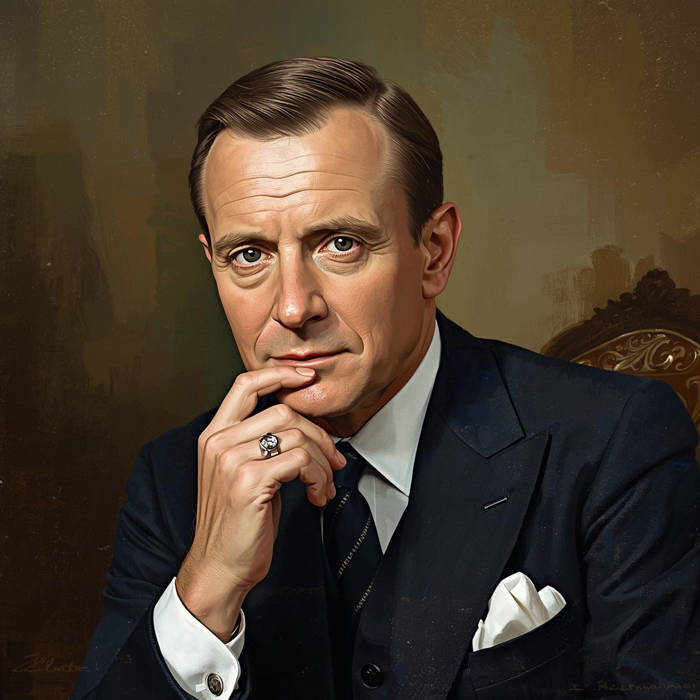
The Man Behind the World’s Most Famous Spy
Few characters in 20th-century literature and cinema have achieved the mythical status of James Bond. The suave, daring British secret agent known by his code number — 007 — has become a universal symbol of style, intrigue, and adventure. But behind this immortal icon stands a man whose life was nearly as fascinating as the one he imagined: Ian Fleming.
Born into privilege, shaped by war, and inspired by his experiences in intelligence and journalism, Fleming created not just a spy but a cultural archetype. His work redefined modern thrillers, merged realism with glamour, and bridged the gap between Cold War anxieties and fantasy escapism.
This article explores the life, mind, and legacy of Ian Fleming — the writer, the intelligence officer, and the man who changed popular culture forever. ✍️
1. Early Life: A Gentleman with a Restless Mind
Ian Lancaster Fleming was born on May 28, 1908, into a wealthy family in London. His father, Valentine Fleming, was a Conservative MP who died heroically in World War I. Young Ian was educated at Eton College and later attended Sandhurst, Britain’s elite military academy.
Yet, unlike his disciplined surroundings, Fleming was rebellious and independent-minded. He had little patience for strict institutions, preferring adventure, fast cars, and romantic escapades — qualities that would later define his fictional hero.
In the 1930s, Fleming tried several careers — foreign correspondent for Reuters, banker, stockbroker — but nothing truly satisfied him. Still, his experiences abroad gave him deep insight into international politics, espionage, and diplomacy, planting the seeds for the world he would later create. 🌍
2. World War II and the Birth of a Spy Writer 🕵️♂️
When World War II broke out, Fleming found his true calling. He joined British Naval Intelligence, serving as personal assistant to Rear Admiral John Godfrey. It was here that he learned the real tradecraft of espionage — cryptography, counterintelligence, sabotage operations, and psychological warfare.
Fleming’s wartime career was both secretive and creative. He helped devise Operation Goldeneye, a surveillance plan in case of a Nazi invasion of Spain and Gibraltar — a name he would later reuse for one of his Jamaican estates and for a future Bond film.
Many of the characters and institutions in the James Bond novels were inspired by Fleming’s wartime experiences:
- M, Bond’s mysterious superior, was based on Admiral Godfrey.
- The Secret Intelligence Service (MI6) mirrored Fleming’s real intelligence network.
- The exotic villains and high-stakes missions echoed his encounters with spies and double agents.
In short, Fleming lived the espionage life before writing it. The realism and authority of his novels stemmed not from fantasy but from experience.
3. The Creation of James Bond: A Blend of Fantasy and Reality
After the war, Fleming settled into a new life as a journalist and foreign manager for The Sunday Times. Yet, his imagination remained restless.
In 1952, while vacationing at his estate in Jamaica — which he named Goldeneye — Fleming decided to write “the spy story to end all spy stories.” That year, he penned Casino Royale, introducing the world to James Bond.
Fleming later admitted that Bond was “a composite of all the secret agents and commandos I met during the war.” But there was also much of Fleming himself in the character:
- Bond’s taste for luxury mirrored his own — tailored suits, fine wines, and fast cars.
- His cynicism and charm reflected Fleming’s worldly skepticism.
- Even Bond’s habits — smoking, drinking martinis “shaken, not stirred,” and womanizing — were drawn from the author’s personal life.
Bond’s name, meanwhile, came from an ornithologist whose book Fleming owned: Birds of the West Indies. He wanted a name that sounded “as ordinary as possible” — the perfect cover for a man of extraordinary abilities.
4. Themes and Style: Glamour Meets Violence
Fleming’s novels, beginning with Casino Royale (1953), captured the post-war mood of Britain — a nation rebuilding itself, anxious about the Cold War, yet dreaming of sophistication and adventure.
His writing style was direct, fast-paced, and cinematic — ideal for readers who wanted both escapism and realism. Fleming combined thrilling plots with luxurious details: high-stakes poker games in Monte Carlo, car chases along the Riviera, and exotic villains with bizarre obsessions.
Beneath the glamour, however, Fleming explored deeper themes:
- The morality of espionage — Is killing justified for a greater good?
- The decline of British power — Bond as the last gentleman of a fading empire.
- The duality of man — sophisticated yet ruthless, charming yet deadly.
Fleming once said that his goal was to provide readers with “a healthy dose of violence, sex, and danger.” But what made his books enduring was their intelligence — a reflection of a world caught between modernity and moral ambiguity.
5. The Bond Phenomenon: From Page to Screen 🎬
By the late 1950s, the James Bond novels had gained a cult following. However, it was the film adaptations that turned Bond into a global phenomenon.
In 1962, Dr. No hit theaters, starring Sean Connery as Bond. The movie’s blend of charm, action, and exotic escapism perfectly captured the spirit of Fleming’s creation. The success was immediate — and James Bond became a cinematic legend.
Over the decades, six actors would portray 007: Connery, George Lazenby, Roger Moore, Timothy Dalton, Pierce Brosnan, and Daniel Craig — each bringing a new dimension to the role.
What made Bond timeless was his ability to evolve with history:
- In the 1960s, he embodied Cold War glamour.
- In the 1980s, he adapted to high-tech espionage.
- In the 2000s, with Daniel Craig, he became darker and more psychologically complex — closer to Fleming’s original vision.
The Bond franchise, now spanning 25 films, remains one of the most successful in cinema history. Yet, it all began with Fleming’s imagination and his sharp sense of human nature.
6. Ian Fleming’s Other Works and Interests ✍️
Although best known for Bond, Fleming also wrote other works that revealed his versatility:
- Chitty Chitty Bang Bang (1964) – A children’s adventure story written for his son Caspar. It later inspired a beloved film and musical. 🚗💨
- The Diamond Smugglers (1957) – A nonfiction exposé on real-world diamond trafficking.
- Thrilling Cities (1963) – A travelogue based on Fleming’s journalistic trips to exotic destinations.
These works demonstrate Fleming’s curiosity and global awareness — qualities that also shaped his spy fiction.
7. The Man Behind the Myth: Flaws and Fascinations
Fleming’s personal life was as complex as his characters. He was charismatic but troubled, brilliant yet self-destructive. His marriage to Ann Charteris was stormy, marked by infidelities on both sides.
He was also a man of contradictions: a patriot who distrusted authority, an elitist who admired individual rebellion. His vices — heavy smoking, drinking, and stress — ultimately took a toll on his health.
Ian Fleming died in 1964, at the age of 56, just two weeks after the birth of his only son. Ironically, his death coincided with Bond’s rise to global fame.
8. Legacy: The Eternal Spy 🕶️
More than sixty years after his death, Ian Fleming’s influence remains immense. James Bond continues to dominate literature, film, fashion, and even music. The series inspired countless imitators — from Jason Bourne to Mission: Impossible — and helped define the modern spy thriller genre.
Beyond entertainment, Bond also reflects a cultural mirror:
- The Cold War tensions of the 1960s.
- The gender and political shifts of later decades.
- The ongoing fascination with espionage, identity, and power.
In recent years, scholars have re-evaluated Fleming’s work, recognizing its literary and psychological depth. Far from being mere pulp fiction, his stories explore timeless questions about loyalty, courage, and morality in a dangerous world.
9. Ian Fleming’s Enduring Relevance in Pop Culture
Even today, Fleming’s creation influences not only film and literature but also global branding and design. From Aston Martin cars to Omega watches, Bond aesthetics have become shorthand for sophistication.
The line “Bond, James Bond” is instantly recognizable across generations — a testament to the power of storytelling.
Moreover, Fleming’s Goldeneye estate in Jamaica remains a cultural landmark, now transformed into a luxury resort visited by celebrities and writers. It is a fitting symbol of his enduring blend of elegance and adventure. 🌴✨
Conclusion: The Writer Who Lived Like His Hero
Ian Fleming was not merely the creator of James Bond — he was James Bond in spirit: a man of contradictions, sophistication, and danger. His life embodied the tension between fantasy and reality, duty and desire, art and escapism.
In the end, Fleming gave the world more than a fictional spy — he gave it a modern myth. A myth that continues to evolve, entertain, and inspire.
As Fleming once said:
“I wanted Bond to be the kind of man every man would like to be, and every woman would want to be with.”
Decades later, that wish has come true. Ian Fleming’s imagination not only changed the way we view espionage but also how we dream about heroism, elegance, and adventure. 🍸🔥
Sources:
- Lycett, Andrew. Ian Fleming: The Man Behind James Bond.
- Parker, Matthew. Goldeneye: Where Bond Was Born.
- The Ian Fleming Estate Archives.
- The British Library – “Ian Fleming and the Creation of James Bond.”
- BBC History – Ian Fleming: The Spy Who Wrote Spy Stories.

